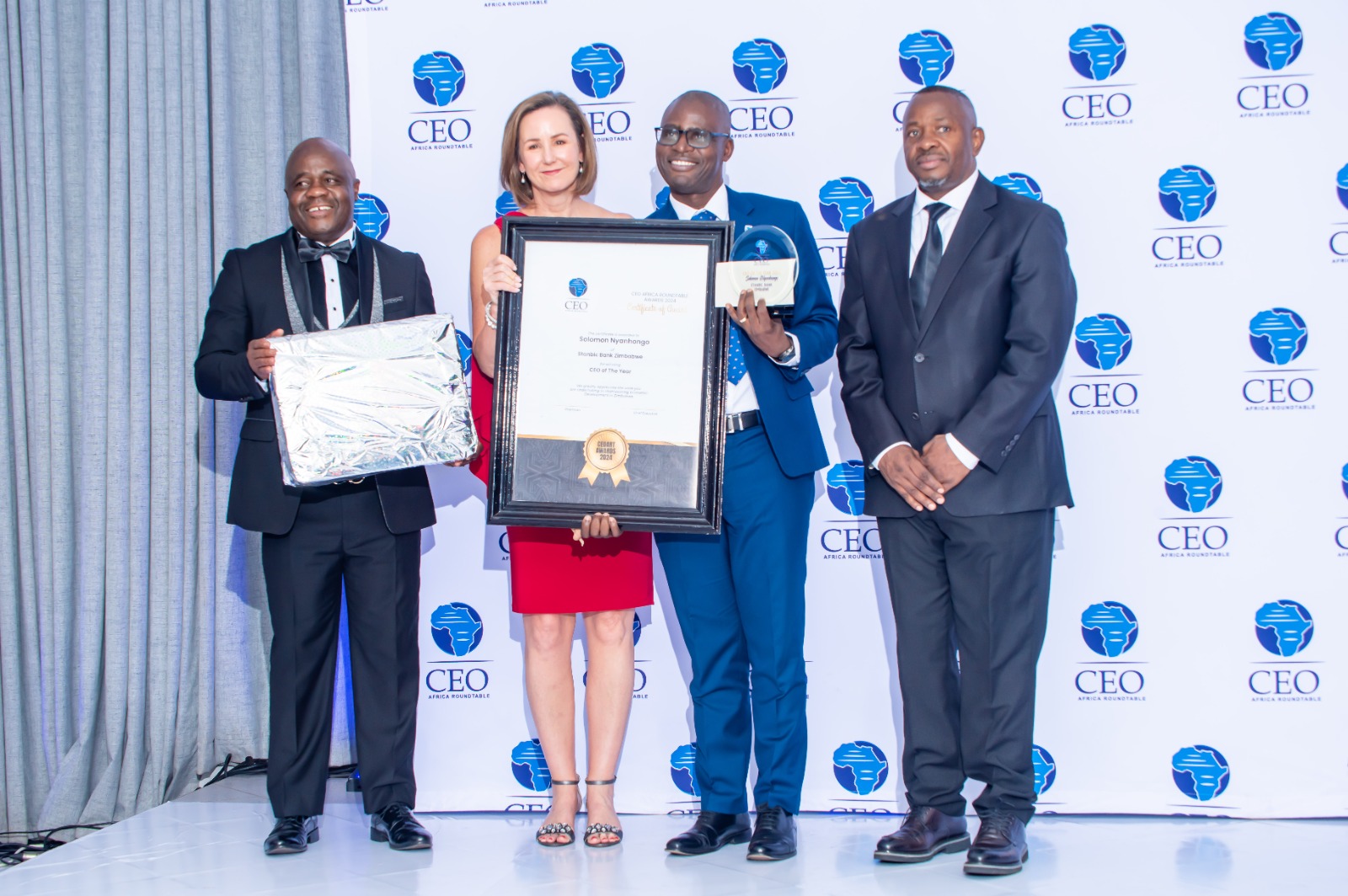Nyanhongo lands CEO of the year awards

BUSINESS WRITER
Stanbic Bank Zimbabwe Chief Executive (CE), Solomon Nyanhongo has landed the overall Chief Executive Officer (CEO) of the year as well as the Banking sector CEO of the year awards at the prestigious annual CEO Round Table Awards ceremony.
A five-member adjudication committee made of seasoned players in banking, law, accounting, media and investment and finance judged nominees on eight categories – Business performance; Corporate & Strategy; Digital Journey; Customer Experience; Risk Management; Product Mix; Product Innovation; and Ethical Leadership & Management.
Chaired by Lawyer, entrepreneur and educationist, Canaan Dube, the adjudication committee rewarded Nyanhongo for guiding Stanbic Bank to greater heights in its business performance as measured by revenue growth as well as Leadership and Corporate Strategy whose indicator was strategic foresight.
The committee rewarded Nyanhongo for championing the implementation of the institution’s three strategic priorities, that is, transform client experience, execute with excellence, drive sustainable growth and value.
The Committee said Nyanhongo was recognised for steering the Standard Bank Group subsidiary through a highly innovative digital journey with the institution registering the highest percentage of digitised customers.
Stanbic Bank’s journey towards digital transformation has been impactful, with 48% of its clients now fully digitized. Up to 94% of the 14.1 million transactions undertaken this year were conducted on digital channels.
This shift demonstrates Stanbic Bank’s clients’ trust in its digital platforms and reflects the institution’s commitment to enhancing accessibility, convenience, and efficiency in every interaction.
Dube said Nyanhongo was rewarded for creating top-notch customer experience through which the institution had highest levels of customer satisfaction and customer retention.
Stanbic Bank Zimbabwe won the Best Customer Experience Award in the Banking Category from the Customer Experience Association of Zimbabwe. The institution has won the award for the past two years. Customer satisfaction across Stanbic Bank’s segments averaged 8.5 out of 10 suggesting that the institution’s clients are highly satisfied with the services they provide them.
The leading financial services institution’s risk management was ahead of the rest on the back of satisfactory percentage of Non-performing Loans over the total loan books; Product diversity, revenue mix looking at what percentage of revenue came from bank charges. To that end, 36% of the Bank’s total revenue as at October 31 2024 was in transactional revenues.
A 0.7% non-performing loan (NPL) ratio is an excellent indicator of financial health, showing that only a very small portion of the loan portfolio is not generating income for Stanbic Bank.
Stanbic Bank’s attention to product innovation saw it being rewarded for launching more new products than any other financial services institution while it reigned in on incidents of misconduct or ethical breaches.
The Bank introduced a Loyalty Programme for its Private Banking Clients. Customers were issued with a Loyalty card which allows them access to a wide range of benefits. In 2024 Stanbic Bank launched two services – free travel insurance and free lounge access at the airport.
As part of its Financial Inclusion drive the Bank introduced a low-cost account Blue Ease this year and to date has opened 743 accounts.
Stanbic Bank recently introduced Green Energy Financing for clients in the renewable energy space as part of its Sustainability drive.
Dube said the Adjudication Committee, was guided by the principle of maintaining the integrity of the award process, and thus strictly adhered to conflict-of-interest guidelines.
“Each nominee was assessed against a predefined set of criteria, ensuring a consistent and objective evaluation. The selection of the overall winner involved a multi-faceted approach, part of which was that Nominees who were selected as sector winners by the majority of adjudicators were considered,” said Dube.
The level of competition within each sector, as indicated by the number of participants, was taken into account as well as the nominee’s organization’s impact on a national scale.
Sector Winners were drawn from Agribusiness; Banking; Education; Energy; Health; ICT; Insurance; Manufacturing; and Professional Services; Real Estate and Construction; Regulatory Authorities; Retail; Tourism and Hospitality; Transport and Logistics; and Young CEO.
“As the Adjudication Committee, we are confident that we conducted a fair and transparent evaluation process based on the information provided by the nominees. We are proud of the outcomes that were unveiled,” said Dube.
Stanbic Bank shook off the prevailing economic challenges to post a historical cost profit of ZWG27.1 million for the six months ended 30 June 2024 amid changes in functional currency from ZWL.
The historical cost profit of ZWG27.1 million was achieved after taking into account the technical losses of ZWG389 million (ZWG319 million net after tax) incurred on the investment property portfolio.
In a statement accompanying financial results recently, Stanbic Bank Chief Executive Solomon Nyanhongo said without these losses, the adjusted profit (commonly referred to as “headline earnings”) is ZWG346 million, and this represents the true, sustainable performance into the future.
Nyanhongo said following the change in the Bank’s functional currency from the Zimbabwe Dollar (“ZWL”) as at 1 January 2024, there were technical accounting adjustments that were included in the Bank’s Income Statement and Statement of Comprehensive Income.
“These adjustments arose from differences in fair values of property assets when expressed in the hitherto ZWL functional currency compared to the underlying valuations in the open market in real terms,” said Nyanhongo.
Stanbic Bank ended the first half of the year with net interest income of ZWG374 million which was within expectation supported largely by new foreign currency lending assets which were written during the period as demand for foreign currency facilities remained high.

